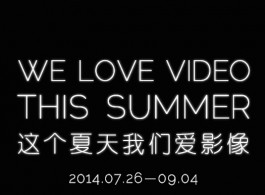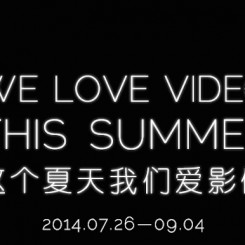Pace Beijing is delighted to announce the opening of a summer group show “We Love Video This Summer” on July 26, 2014. This is Pace Beijing’s very first attempt to devote its entire gallery space merely to video/motion graphic art. We hope in this temporary community formed by space, image, voice, and even the viewers could generate a physical and psychological resonance, make each individual work as a full force field to unleash greater openness, as well as renew and challenge the viewer’s experience as a participant. Between works and works, and works and the audience, the chain of meaning and experience will continue to join and disintegrate, and the 2000 m2 exhibition space of Pace Beijing will become a laboratory for new relations in video art observation.
Therefore, the title of this exhibition does not provide any descriptive or diagnostic information. On the contrary it is an emotional and simple move. We intentionally minimize the traditional sense of curatorial clues, themes, chronologies and taxonomic restrictions added to works or artists. In a sense, “We Love Video This Summer” is a free rehearsal for practitioners in a specific space of authigenic dialogue, communication, and performance. The artists exhibited are from different countries, regions, cultures and historical environments, with all kinds of creative backgrounds, concepts and contexts. Some of them are long-time pioneer explorers of video art, some are young artists with passion and faith of video language or video itself, while some others are people who walk on this path because of their belief in changing the world with the power of video art. In this exhibition, we wish to build a platform for these explorers and practitioners for the oncoming, tuber-like narrative of freedom.
The exhibition absorbs multiple video/motion graphic art to the extreme: the video art pioneer Bill Viola maintained his consistent theme in his work “Visitation”, which is to show the intersection between life and death and the deformation process cycle in the flow and blink of image. Song Dong, the Chinese video precursor in his five-channel video “I don’t know” catches the changes of objects and time with purified and near abstract image language. Yuan Goang-ming (Taiwan) also seizes the image itself during his years of creation, and treats images as an unknown beyond the recognition of language. His work shown in the 300 m2 separates space, and with the driven of image, the audience’s present experience is under potential variation and rebirth. Tseng Yu-Chin, on the other hand, is using his highly recognizable visuals to force the boundary of narrative and communication, and to explore the global existence of individuals through the body and senses.
Also is a forerunner of video art, Qiu Anxiong in his new work “Cake” utilizes comprehensive language full of extremely strong style and materiality, and to calmly describe a cruel and ambiguous wrestle. Shen Ruijun, a young curator and artist re-discusses the limits of painting on a flat surface and painting as a process in a peaceful, elegant, and smart way. More freedom can be sensed in Pak Sheung Chuen’s “To breathe a roomful air”. The artist recorded his residence in Busan where he collected his own breathe using plastic bags. This nuances of individual life experience in this particular way connects the room in an unconventional way – the everyday breathing process opened another perception and acceptance of the passage of life following the deliberately stress and strip.
With the impact of new technologies, a number of new comprehensive video works have gradually become fashionable, and how to define them is still in the process of modification and adjustment. In this exhibition, a creative team from Japan named teamLab created science and bionic art with the minimum recognition of their existence – they produce/manufacture loop and endless video art as a group. While Norwegian artist Pia Myrvold combines art, fashion, photography, performance, and interactive technology, and introduces the concept of “interface” to the works, allowing the audience’s static relationship with the art becomes blur and fueled with impetus.
Lastly, the political nature and a sense of practice on difference levels are also reflected in most of the works in this exhibition. Israel artist Mochal Rovner adheres to themes such as identification and segregation which are both political and personal, and transforms geographical concepts into the visual expression of walking, or explains cultural/social narratives including live and death, confrontation and floating using abstract metaphors. Young artists such as Tsui Kuang-Yu who are more like activists usually turn the record of action into methodology. By showing how the leading character (the artist himself) deal with the surrounding environment, explore the possibility of a new relationship between individual and environment, and try to ask and click the hidden problems in life, the artist eventually finds and practices a set of method of the individual, and his video work is just a presentation of these methods. Morgan Wong, an emerging artist uses fuzzy symbolism, intentional sense of alienation and a likely provocation, to translate political, questioning, and participating into a brand new discussion space that is pure and fresh.
The exhibition will end on 4 September, 2014.
Artists:
Pia Myrvold
Pak Sheung Chuen
Adam Pendleton
Qiu Anxiong
Michal Rovner
Shen Ruijun
Song Dong
teamLab
Tseng Yu-Chin
Tsui Kuang-Yu
Bill Viola
Morgan Wong
Yuan Goang-Ming


